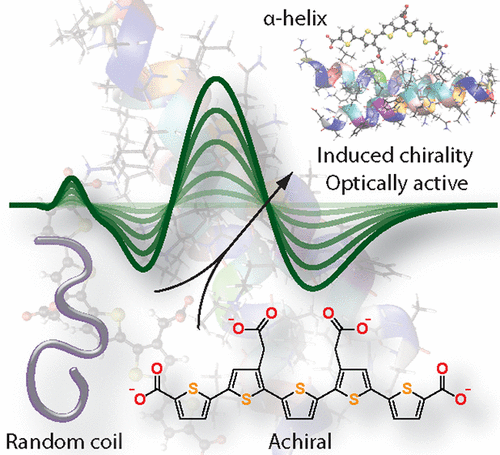当前位置:
X-MOL 学术
›
Macromolecules
›
论文详情
Our official English website, www.x-mol.net, welcomes your
feedback! (Note: you will need to create a separate account there.)
Distinct Electrostatic Interactions Govern the Chiro-Optical Properties and Architectural Arrangement of Peptide–Oligothiophene Hybrid Materials
Macromolecules ( IF 5.1 ) Pub Date : 2017-09-14 00:00:00 , DOI: 10.1021/acs.macromol.7b01855 Robert Selegård , Zeinab Rouhbakhsh , Hamid Shirani , Leif B. G. Johansson , Patrick Norman 1 , Mathieu Linares 1 , Daniel Aili , K. Peter R. Nilsson
Macromolecules ( IF 5.1 ) Pub Date : 2017-09-14 00:00:00 , DOI: 10.1021/acs.macromol.7b01855 Robert Selegård , Zeinab Rouhbakhsh , Hamid Shirani , Leif B. G. Johansson , Patrick Norman 1 , Mathieu Linares 1 , Daniel Aili , K. Peter R. Nilsson
Affiliation

|
The development of chiral optoelectronic materials is of great interest due to their potential of being utilized in electronic devices, biosensors, and artificial enzymes. Herein, we report the chiral–optical properties and architectural arrangement of optoelectronic materials generated from noncovalent self-assembly of a cationic synthetic peptide and five chemically defined anionic pentameric oligothiophenes. The peptide–oligothiophene hybrid materials exhibit a three-dimensional ordered helical structure and optical activity in the π–π* transition region that are observed due to a single chain induced chirality of the conjugated thiophene backbone upon interaction with the peptide. The latter property is highly dependent on electrostatic interactions between the peptide and the oligothiophene, verifying that a distinct spacing of the carboxyl groups along the thiophene backbone is a major chemical determinant for having a hybrid material with distinct optoelectronic properties. The necessity of the electrostatic interaction between specific carboxyl functionalities along the thiophene backbone and the lysine residues of the peptide, as well as the induced circular dichroism of the thiophene backbone, was also confirmed by theoretical calculations. We foresee that our findings will aid in designing optoelectronic materials with dynamic architectonical precisions as well as offer the possibility to create the next generation of materials for organic electronics and organic bioelectronics.
中文翻译:

独特的静电相互作用控制肽-寡聚噻吩杂化材料的手性光学性质和体系结构
由于手性光电材料被用于电子设备,生物传感器和人工酶的潜力,引起了人们极大的兴趣。在这里,我们报道了由阳离子合成肽和五个化学定义的阴离子五聚体低聚噻吩的非共价自组装产生的光电子材料的手性-光学性质和结构排列。肽-寡聚噻吩杂化材料在π-π*过渡区表现出三维有序的螺旋结构和光学活性,这是由于与肽相互作用时共轭噻吩主链的单链诱导手性所致。后者的特性高度依赖于肽与寡噻吩之间的静电相互作用,证实沿着噻吩主链的羧基间距明显是具有具有不同光电特性的杂化材料的主要化学决定因素。通过理论计算也证实了沿着噻吩主链的特定羧基官能团与肽的赖氨酸残基之间静电相互作用的必要性,以及噻吩主链的诱导的二向色性。我们预见,我们的发现将有助于设计具有动态架构精度的光电材料,并为创建用于有机电子和有机生物电子的下一代材料提供了可能性。通过理论计算也证实了沿着噻吩主链的特定羧基官能团与肽的赖氨酸残基之间静电相互作用的必要性,以及噻吩主链的诱导的二向色性。我们预见,我们的发现将有助于设计具有动态架构精度的光电材料,并为创建用于有机电子和有机生物电子的下一代材料提供了可能性。通过理论计算也证实了沿着噻吩主链的特定羧基官能团与肽的赖氨酸残基之间静电相互作用的必要性,以及噻吩主链的诱导的二向色性。我们预见,我们的发现将有助于设计具有动态架构精度的光电材料,并为创建用于有机电子和有机生物电子的下一代材料提供了可能性。
更新日期:2017-09-14
中文翻译:

独特的静电相互作用控制肽-寡聚噻吩杂化材料的手性光学性质和体系结构
由于手性光电材料被用于电子设备,生物传感器和人工酶的潜力,引起了人们极大的兴趣。在这里,我们报道了由阳离子合成肽和五个化学定义的阴离子五聚体低聚噻吩的非共价自组装产生的光电子材料的手性-光学性质和结构排列。肽-寡聚噻吩杂化材料在π-π*过渡区表现出三维有序的螺旋结构和光学活性,这是由于与肽相互作用时共轭噻吩主链的单链诱导手性所致。后者的特性高度依赖于肽与寡噻吩之间的静电相互作用,证实沿着噻吩主链的羧基间距明显是具有具有不同光电特性的杂化材料的主要化学决定因素。通过理论计算也证实了沿着噻吩主链的特定羧基官能团与肽的赖氨酸残基之间静电相互作用的必要性,以及噻吩主链的诱导的二向色性。我们预见,我们的发现将有助于设计具有动态架构精度的光电材料,并为创建用于有机电子和有机生物电子的下一代材料提供了可能性。通过理论计算也证实了沿着噻吩主链的特定羧基官能团与肽的赖氨酸残基之间静电相互作用的必要性,以及噻吩主链的诱导的二向色性。我们预见,我们的发现将有助于设计具有动态架构精度的光电材料,并为创建用于有机电子和有机生物电子的下一代材料提供了可能性。通过理论计算也证实了沿着噻吩主链的特定羧基官能团与肽的赖氨酸残基之间静电相互作用的必要性,以及噻吩主链的诱导的二向色性。我们预见,我们的发现将有助于设计具有动态架构精度的光电材料,并为创建用于有机电子和有机生物电子的下一代材料提供了可能性。











































 京公网安备 11010802027423号
京公网安备 11010802027423号